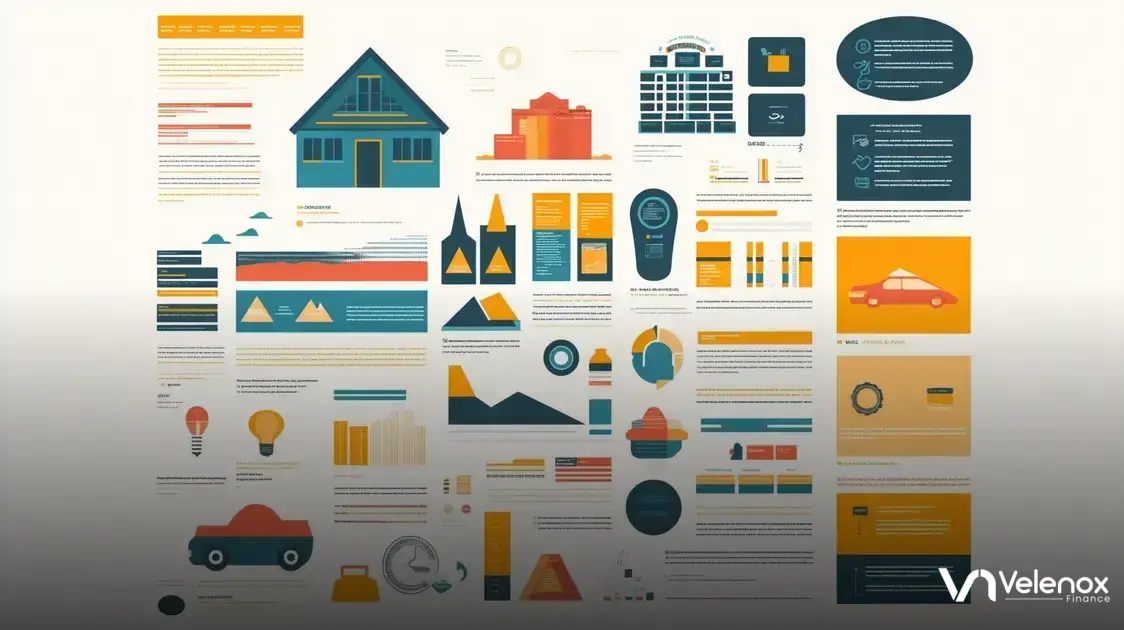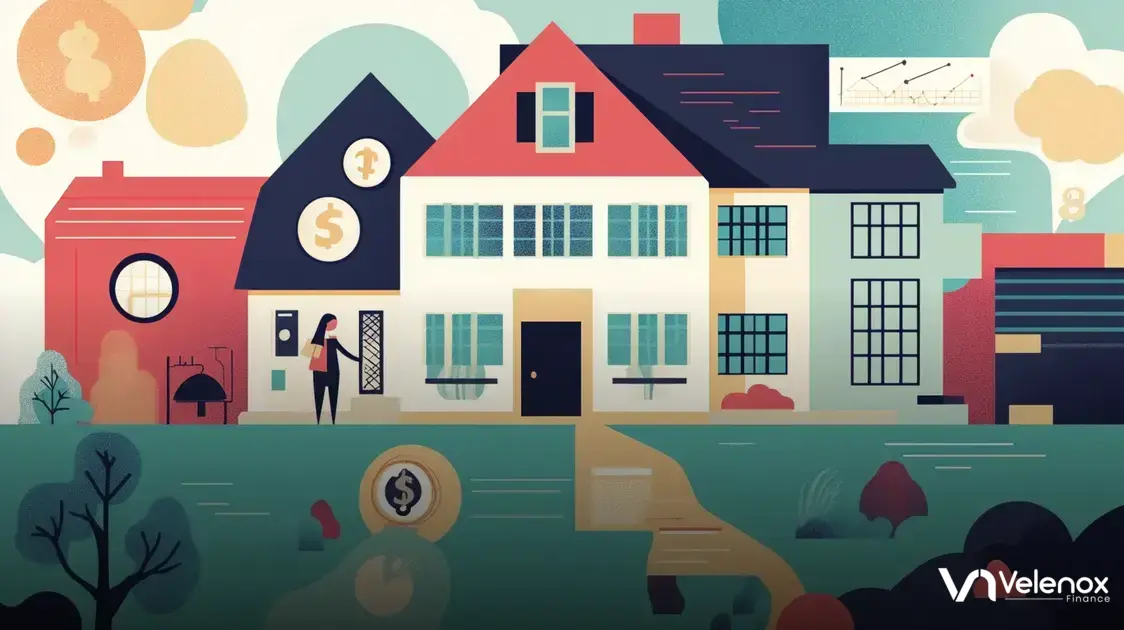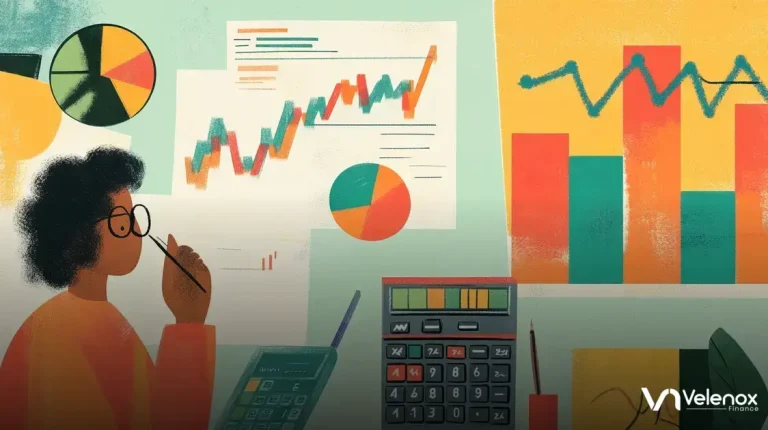In today’s financial landscape, loan rates can significantly impact your borrowing power and financial decisions.
Understanding how loan rates function is essential for individuals and businesses alike.
Understanding Loan Rates
Understanding loan rates is essential for anyone looking to borrow money. Loan rates determine how much you will pay back in interest over the life of your loan.
These rates can vary significantly based on several factors and can influence your overall financial health.
What Are Loan Rates?
Loan rates are the interest rates charged by lenders when you take out a loan.
These rates can be fixed, meaning they stay the same throughout the loan period, or variable, meaning they can change over time.
Understanding these differences is crucial when deciding which loan to choose.
Why Do Loan Rates Matter?
The higher your loan rate, the more money you will pay in interest. This can add up significantly, especially for large loans such as mortgages or car loans.
Understanding your loan rate helps you budget and manage your finances more effectively.
The Impact of Economic Trends
Loan rates are influenced by economic factors such as inflation, the Federal Reserve’s interest rate, and overall market dynamics.
During times of economic growth, loan rates may rise, while they might fall during a recession. Staying informed about these trends can help you time your loan application for better rates.
Checking Your Loan Rate
Lenders often use your credit score to determine your loan rate.
A higher score usually means a lower rate. Before applying, check your credit score and make necessary improvements.
This will give you a better chance of securing a more favorable loan rate.
Types of Loans and Their Rates
Different loans come with different rates. For example, personal loans often have higher rates than secured loans like home mortgages.
It’s essential to understand the specific loan type you are considering and how its rate compares to others.
How to Negotiate Your Loan Rate
You may have room to negotiate your loan rate. Researching other lenders can provide leverage when discussing rates with your preferred lender.
Don’t hesitate to ask for a better rate, especially if you have a strong credit profile.
Factors Influencing Loan Rates
Several factors can influence loan rates, making it essential for borrowers to understand what affects these rates before applying for a loan.
1. Credit Score
Your credit score is one of the most critical factors that lenders consider. A higher credit score generally means lower loan rates.
This score reflects your credit history and your ability to repay borrowed money.
2. Economic Conditions
The overall economic environment plays a significant role in determining loan rates. When the economy is strong, loan demand increases, which can lead to higher rates.
Conversely, during economic downturns, rates may fall to encourage borrowing.
3. Inflation
Inflation affects purchasing power and can lead lenders to raise rates to maintain profit margins.
Understanding the inflation rate in your area can give insight into potential fluctuations in loan rates.
4. Federal Reserve Policies
The Federal Reserve sets the baseline interest rates that influence all other rates, including loan rates.
When the Fed raises or lowers these rates, it has a ripple effect on loan rates across the board.
Staying informed about Fed announcements can help you gauge future rate changes.
5. Loan Type
The type of loan you choose will also affect your rate.
Secured loans, like mortgages, typically have lower rates compared to unsecured loans, like personal loans. Understanding the differences is key when selecting a loan.
6. Loan Amount
Larger loans may have different rate structures than smaller loans.
Sometimes, borrowing a more considerable sum can result in a lower rate since lenders view larger loans as more secure.
7. Loan Term
The term length of your loan also influences the rate. Shorter-term loans often have lower rates because lenders face less risk over a shorter period.
However, the monthly payments may be higher.
8. Market Competition
Competition among lenders can result in better rates for consumers. When multiple lenders offer similar loans, they may reduce rates to attract more borrowers.
Comparing offers from different lenders is crucial to getting the best deal.
9. Regional Factors
Where you live can impact loan rates. Certain regions may have higher costs of living, which can lead to higher rates.
It’s essential to research regional differences in loan rates to make informed choices.
How to Compare Loan Rates

Comparing loan rates is crucial for finding the best deal possible. Here are some essential steps to help you compare rates effectively.
1. Gather Loan Offers
Start by collecting loan offers from multiple lenders. You can visit banks, credit unions, and online lenders to find various rates.
Make sure to get the same loan type and amount for accurate comparisons.
2. Check the Annual Percentage Rate (APR)
The APR includes both the interest rate and any fees associated with the loan.
This rate provides a clearer picture of the total cost of borrowing over time. Always compare APRs rather than just interest rates.
3. Understand Loan Terms
Loan terms can affect your monthly payments and overall costs.
Shorter terms may have higher monthly payments but lower total interest costs, while longer terms may offer lower payments but higher total interest.
4. Look at Fees Involved
Different loans come with different fees, such as origination fees, closing costs, and application fees.
Make sure to consider these fees when comparing loan rates, as they can add significantly to the overall cost.
5. Use Online Comparison Tools
Many websites offer loan comparison tools that make it easy to see rates from various lenders side by side.
Utilizing these tools allows you to save time and spot the best deals quickly.
6. Assess Customer Reviews
Customer reviews can give insight into a lender’s service quality. A lender with competitive rates but poor customer service may not be worth the savings.
Check for reviews on platforms like Yelp or Trustpilot.
7. Prequalification and Soft Inquiries
Many lenders allow you to prequalify for a loan with a soft inquiry, which won’t affect your credit score.
This step helps you understand what rates you may qualify for without a hard pull on your credit.
8. Ask About Discounts
Some lenders offer discounts for setting up automatic payments or for being a loyal customer.
Don’t hesitate to ask lenders if they have any available discounts that could lower your rate.
9. Keep Your Credit in Good Shape
Before finalizing any loan, ensure your credit score is in good shape, as this will impact the rates you’re offered.
If necessary, take steps to improve your credit score to qualify for better rates.
Tips for Securing Low Loan Rates
Securing low loan rates can save you a significant amount of money in the long run. Here are some effective tips to help you achieve the best rates possible.
1. Improve Your Credit Score
One of the most effective ways to secure low rates is by improving your credit score.
Pay off debts, make payments on time, and reduce credit utilization before applying for a loan. A higher credit score can lead to better rates.
2. Shop Around for Lenders
Don’t settle for the first offer you receive. Compare rates from multiple lenders, including banks, credit unions, and online lenders.
Each lender has different criteria and offers, so shopping around can provide better options.
3. Consider a Co-Signer
If your credit is not strong, consider asking a trusted individual with good credit to co-sign the loan. This can increase the chances of getting approved for a lower rate.
4. Choose the Right Loan Type
Different types of loans come with varying rates and terms.
Research the types of loans available and choose the one that offers the best combination of low rates and terms that suit your needs.
5. Opt for a Shorter Loan Term
Shorter loan terms typically come with lower interest rates.
While your monthly payments might be higher, the total interest paid over the life of the loan will be less.
6. Lock in Your Rate
If you find a favorable rate, ask your lender if you can lock it in. Rate locks can protect you from potential increases during the loan approval process.
7. Make a Larger Down Payment
If applicable, consider making a larger down payment. This reduces the loan amount and can result in a lower rate since you present less risk to the lender.
8. Maintain a Stable Income
Having a stable income can improve your chances of securing a low rate. Lenders like to see consistent income, which suggests reliable repayment ability.
9. Be Aware of Economic Changes
Stay informed about economic trends and interest rate changes. Timing your loan application during favorable economic conditions can lead to lower rates.
Impact of Credit Scores on Loan Rates
Your credit score has a significant impact on the loan rates you may receive.
Lenders use this score to assess your creditworthiness and ability to repay borrowed money.
1. What is a Credit Score?
A credit score is a numerical representation of your credit history and pays attention to factors like payment history, amounts owed, and length of credit history.
The score typically ranges from 300 to 850, with a higher score indicating better credit.
2. How Credit Scores Affect Loan Rates
Lenders look at your credit score to determine how much risk you pose.
If you have a high credit score, you are seen as a low risk, and therefore, lenders are more likely to offer you lower loan rates.
Conversely, a lower score may lead to higher rates.
3. Different Score Ranges
Credit scores are categorized into different ranges:
- Excellent (800-850): You usually qualify for the best loan rates.
- Good (700-799): Generally, you still receive competitive rates.
- Fair (650-699): Rates may be higher, but options are still available.
- Poor (300-649): You may face the highest rates or limited options.
4. The Role of Credit History
Your credit history is also essential. Lenders examine how you manage credit over time.
Late payments, defaults, or bankruptcies can negatively affect your score and lead to higher loan rates.
5. Improving Your Credit Score
Before applying for a loan, consider improving your credit score. This can be done by paying off debts, reducing credit card balances, and making all payments on time.
6. The Importance of Credit Monitoring
Regularly monitoring your credit report can help you identify errors or issues that impact your score.
Fixing these errors can improve your chances of securing better loan rates.
7. Understanding Lender Requirements
Different lenders have varying requirements for acceptable credit scores. Research multiple lenders to see what scores are needed for the best rates.
Types of Loans and Their Rates

When considering a loan, it’s essential to understand the different types of loans available and their respective rates.
Each type of loan serves different purposes and comes with its own set of terms.
1. Personal Loans
Personal loans are unsecured loans that can be used for various purposes such as debt consolidation or home improvement.
These loans typically have higher interest rates than secured loans due to their unsecured nature.
2. Mortgages
Mortgages are loans specifically for purchasing real estate. They usually have lower rates compared to personal loans because they are secured by the property.
Rates can vary depending on whether the mortgage is fixed or adjustable.
3. Auto Loans
Auto loans are used to finance the purchase of a vehicle.
These loans are often secured against the car itself, which allows lenders to offer lower rates compared to personal loans.
The rate depends on factors such as your credit score and the loan term.
4. Student Loans
Student loans help finance education costs. These loans may come with lower rates, especially federal student loans, which often have fixed rates.
Private student loan rates, however, vary significantly based on credit score and lender.
5. Home Equity Loans
Home equity loans allow homeowners to borrow against the equity in their homes.
These loans generally have lower rates than personal loans because they are secured by the property.
However, they carry the risk of losing the home if payments are not made.
6. Credit Cards
Credit cards can also be considered a form of borrowing. They generally have higher interest rates compared to other loan types.
However, some cards offer promotional rates or balance transfers that might effectively lower costs.
7. Payday Loans
Payday loans are short-term loans meant to cover expenses until the next paycheck.
These loans usually come with extremely high interest rates and fees and are often considered an option of last resort.
8. SBA Loans
SBA (Small Business Administration) loans are designed to assist small businesses in obtaining financing.
These loans often have lower rates and more favorable terms compared to traditional business loans, but they can be challenging to qualify for.
9. Overview of Loan Rates
Loan rates vary widely by type and lender. Personal loans might have rates from 6% to 36%, while mortgages can range from 3% to 7%.
Always compare loans based on APR to understand their true cost.
Fixed vs. Variable Loan Rates
When considering loans, it is important to understand the difference between fixed and variable loan rates as they can significantly impact your financial decisions.
1. Fixed Loan Rates
A fixed loan rate means that the interest rate remains the same throughout the life of the loan.
This predictability can make budgeting easier, as you will know exactly how much you need to pay each month.
Fixed loan rates are often recommended for long-term loans, such as mortgages, because they protect borrowers from rate increases.
2. Benefits of Fixed Rates
One key benefit of fixed rates is stability. No matter what happens in the economy, your interest rate—and payment amount—will not change.
This can be especially advantageous during times of rising interest rates.
3. Drawbacks of Fixed Rates
While fixed loan rates offer stability, they may come with higher initial rates than variable options. If interest rates fall, you could end up paying more than necessary over time unless you refinance your loan.
4. Variable Loan Rates
Variable loan rates, also known as adjustable rates, can fluctuate based on market conditions.
This means the interest rate can change at predetermined intervals, such as annually or biannually, which can lead to varying monthly payments.
5. Benefits of Variable Rates
The main advantage of variable loan rates is that they often start lower than fixed rates. If market rates decrease, your payment may decrease as well, allowing you to save money.
6. Drawbacks of Variable Rates
The biggest downside to variable rates is unpredictability. Your monthly payments can increase significantly if interest rates rise, which can strain your budget.
This risk makes variable loans less desirable for long-term loans.
7. When to Choose Each Type
Choosing between fixed and variable rates depends on your financial situation and risk tolerance.
If you prefer stability and plan to keep your loan for a long time, a fixed rate may be better.
However, if you’re looking for lower initial payments and can handle potential fluctuations, a variable rate might be suitable.
8. Hybrid Options
Some loans offer hybrid options that combine both fixed and variable rates.
For example, you might have a fixed rate for the first few years, after which it becomes variable.
This can provide the best of both worlds depending on your needs.
The Future of Loan Rates
The future of loan rates is an important topic to consider for anyone looking to borrow money.
Various factors may influence how rates are determined and what borrowers can expect in the coming years.
1. Economic Trends
As the economy evolves, loan rates will likely change in response to economic indicators such as inflation, employment rates, and consumer spending.
A stronger economy may lead to increased rates, while a weaker economy could push rates down.
2. Federal Reserve Policies
The actions of the Federal Reserve have a significant impact on loan rates.
By adjusting interest rates and implementing monetary policies, the Fed can influence borrowing costs.
Future changes in these policies will likely shape the rates borrowers face.
3. Technological Advances
Technology is transforming the lending industry. Online applications, automated underwriting, and data analysis can make loan processing faster and more efficient.
This might lead to more competitive rates as lenders aim to attract customers.
4. Consumer Trends
Shifts in consumer preferences, such as a growing interest in sustainable or socially responsible lending, may lead to new loan products and altered rates.
Lenders may adjust their rates to align with these evolving consumer values.
5. The Rise of Alternative Lending
Alternative lending options, such as peer-to-peer lending or fintech solutions, could disrupt traditional lending practices.
These platforms may offer lower rates and more accessible terms, pushing conventional lenders to adapt.
Common Myths about Loan Rates

There are many myths about loan rates that can confuse borrowers.
Understanding the truth behind these misconceptions is essential when making financial decisions.
1. All Lenders Offer the Same Rates
One common myth is that all lenders offer the same loan rates. In reality, rates can vary widely from lender to lender.
It’s important to shop around and compare offers to find the best deal.
2. Fixed Rates are Always Better
Many people believe that fixed rates are always the best option. While they provide stability, variable rates can sometimes offer lower initial costs.
Depending on your situation, a variable rate may be more advantageous.
3. Credit Scores Do Not Matter Much
Some borrowers think their credit score won’t significantly affect their loan rates.
However, your credit score plays a crucial role in determining the rates you qualify for. A higher score often leads to better rates.
4. The Rate is the Only Cost
Many assume that the interest rate is the only cost associated with loans. However, there are often additional fees, such as origination fees, closing costs, and more.
Always consider the APR for a complete understanding of loan costs.
5. Only Banks Offer Loans
It’s a myth that only traditional banks provide loans.
There are now many options available, including credit unions, online lenders, and peer-to-peer lending platforms, which can offer competitive rates.





